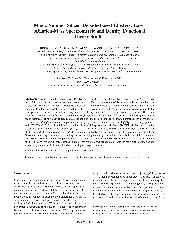摘要
The magic number silica clusters [(SiO2)(n)O2H3](-) with n = 4 and 8 have been observed in the XeCl excimer laser (308 nm) ablation of various porous siliceous materials. The structural origin of the magic number clusters has been studied by the density functional theoretical calculation at the B3LYP/6-31G** level, with a genetic algorithm as a supplementary tool for global structure searching. The DFT results of the first magic number cluster are parallel to the corresponding Hartree-Fock results previously reported with only small differences in the structural parameters. Theoretical calculation predicts that the first magic number cluster (SiO2)(4)O2H4 and its anion [(SiO2)(4)O2H3](-) will most probably take pseudotetrahedral cage-like structures. To study the structural properties of the second magic number cluster, geometries of the bare cluster (SiO2)(8), the neutral complex cluster (SiO2)(8)O2H4, and the anionic cluster [(SiO2)(8)O2H3](-) are fully optimized at the B3LYP/6-31G** level, and the corresponding vibrational frequencies are calculated. The DFT calculations predict that the ground state of the bare silica octamer (SiO2)(8) has a linear chain structure, whereas the second magic number complex cluster (SiO2)(8)O2H4 and its anion [(SiO2)(8)O2H3](-) are most probably a mixture of cubic cage-like structural isomers with an O atom inside the cage and several quasi-bicage isomers with high intercage interactions. The stabilization of these structures can also be attributed to the active participation of the group of atoms 2O and 4H (3H for the anion) in chemical bonding during cluster formation. Our theoretical calculation gives preliminary structural interpretation of the presence of the first and second magic number clusters and the absence of higher magic numbers.
- 出版日期2005-4-30
- 单位复旦大学
